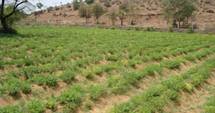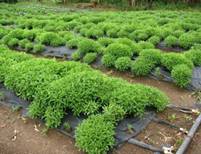Stevia rebaudiana
Compositae
Economic part – leaves
Major constituents- Stevioside (3-10 %), Rebaudiside-A (13 %), Rebaudiside-B and C
Uses - Calorie free sweetner, sugar substitute for diabetic patients
Soil and Climate
Stevia grows well in sandy loam soils with an ample supply of water. Stevia prefers acidic to neutral soil with a pH range of 6.5-7.5 for its best growth. Annual average temperature of 31o C with a rainfall of 140 cm per year has been found optimum for its good growth. The day temperatures should not exceed 48oC and the night temperatures should not fall below 4oC.
Propagation
Stem cuttings of 15 cm length taken from leaf axils of the current year’s growth have been given better results. The best months for propagation are February-March. The cuttings will be ready for transplanting after 25-30 days of rooting
 
Nursery and rooted cuttings

Field preparation
Planting
Rooted cuttings are planted at a spacing of 45X45 cm, with a total plant density in the order of 30,000 plants per ha.
  
Field view
Manuring
27.5:112.5:112.5 kg NPK/ha is recommended for higher yields.
Weed control
Regular weeding must be done after every 2 months in stevia cultivation.
 
Weed management
Harvesting
It can be harvested when plants are 40-60 centimeters in height. Shorter days induce flowering. Optimum yield (biomass) and stevioside quality and quantity is best just prior to flowering.
Yield
An estimated 3-3.5t/ha dry green leaves are obtained from three-four cutting of every year. It is cultivated up to 5 years after a one time plantation.
Drying and Threshing
Depending on weather conditions and density of loading, it generally takes 24 to 48 hours to dry Stevia at 40°C to 50°C. Immediately following drying, a specially designed thresher/separator is necessary to separate dry stevia leaves from its stem.
|








